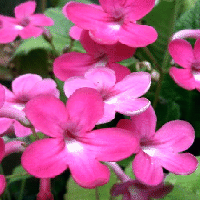 |
GESNERIACEAE - The African Violet Family
This is a family of around 2000 species in 125 genera, most of them tropical herbs and shrubs, rarely trees, with a few occuring in temperate areas of the world. They are grown for ornament, most of them as houseplants in temperate regions. The most well-known species are Aeschyanthus, Columnea, Episcia, Gesneria, Gloxinia, Kohleria, Saintpaulia (African Violet), and Streptocarpus. A few of the hardier species are grown in gardens, notably Ramonda, Jankaea and Mitraria. Some are used in local medicines in tropical areas. |
Characteristics of this Plant Family:
Leaves, Stem & Roots ~ The roots are usually fibrous, or woody tubers or scaly rhizomes. Some have aerial stolons. The leaves are usually opposite or alternate, simple, and may be toothed. The leaves are often softly hairy. On rare occasions, they are pinnatisect, or there may be only one leaf, and there are sometimes basal leaves. There are no stipules. The stems are often fleshy, and may be brittle.
Flowers ~ The flowers are irregular, and have five sepals and five petals, which may be fused into a tube at the base. They may be single, or in racemes, and are often softly hairy. There are 2-4 stamens, and the ovary may be superior or inferior.
Seeds ~ There are many small seeds, contained either in a rounded or elongated capsule, or rarely in a berry.
Members of this Family usually have:
Underground fibrous roots, tubers or scaly rhizomes
Irregular flowers with five sepals and five petals
Many small seeds in a capsule
and are usually tropical herbs or shrubs (rarely trees)
(Thanks to Ron Myhr of www.gesneriads.ca for help with the wording of this page)